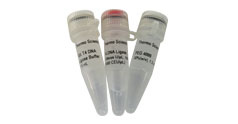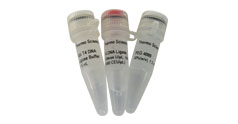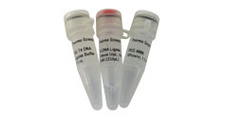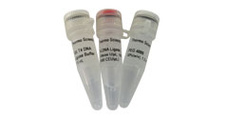T4 DNA Ligase, HC











Detailní popis
Thermo Scientific T4 DNA Ligase catalyzes the formation of a phosphodiester bond between juxtaposed 5'-phosphate and 3'-hydroxyl termini in duplex DNA or RNA. The enzyme repairs single-strand nicks in duplex DNA, RNA, or DNA/RNA hybrids. It also joins DNA fragments with either cohesive or blunt termini, but has no activity on single-stranded nucleic acids (see References 1, 2).
T4 DNA Ligase requires ATP as a cofactor.
Highlights
- Active in Themo Scientific restriction enzyme, PCR, and RT buffers (when supplemented with ATP)
- Fast – sticky-end ligation is completed in 10 minutes at room temperature
- Supplied with PEG solution for efficient blunt-end ligation
Applications
- Cloning of restriction enzyme generated DNA fragments
- Cloning of PCR products
- Joining of double-stranded oligonucleotide linkers or adaptors to DNA
- Site-directed mutagenesis
- Amplified fragment length polymorphism (AFLP)
- Ligase-mediated RNA detection (see Reference 3)
- Nick repair in duplex DNA, RNA or DNA/RNA hybrids
- Self-circularization of linear DNA.
Includes
- T4 DNA Ligase
- 10X T4 DNA Ligase Buffer
- 50% PEG Solution
Notes
- Binding of T4 DNA Ligase to DNA may result in a band shift in agarose gels. To avoid this, incubate samples with 6X DNA Loading Dye & SDS Solution at 70°C for 5 min or 65°C for 10 minutes and chill on ice prior to electrophoresis.
- The volume of the ligation reaction mixture should not exceed 10% of the competent cell volume in the transformation process.
- Prior to electro-transformation, remove T4 DNA Ligase from the ligation mixture using spin columns or chloroform extraction. The extracted DNA can be further precipitated with ethanol.
| 10X T4 DNA Ligase Buffer (#B69) | 400 mM Tris-HCl, 100 mM MgCl2, 100 mM DTT, 5 mM ATP (pH 7.8 at 25°C) |
| 50% PEG Solution | 50% (w/v) polyethylene glycol 4000 |
| Definition of Activity Unit | One Weiss unit of the enzyme catalyzes the conversion of 1 nmol of [32PPi] into Norit-adsorbable form in 20 min at 37° C. One Weiss unit is equivalent to approximately 200 cohesive end units (CEU)*. Enzyme activity is assayed in the following mixture: 66 mM Tris-HCl (pH 7.6), 6.6 mM MgCl2, 0.066 mM ATP, 10 mM DTT, 3.3 µM [32PPi]. * One CEU is defined as the amount of enzyme required to give 50% ligation of HindIII fragments of lambda DNA in 30 min at 16° C. |
| Hazardous | No |
| Inhibition and Inactivation | Inhibitors: T4 DNA Ligase is strongly inhibited by NaCl or KCl if the concentration exceeds 200 mM Inactivated by heating at 65°C for 10 minutes or 70°C for 5 minutes |
| Molecular Weight | 55.3 kDa monomer |
| Quality Control | The absence of endo-, exodeoxyribonucleases, phosphatases, and ribonucleases confirmed by appropriate quality tests. Functionally tested for the capacity to join cohesive- and blunt-end DNA fragments. |
| Source | E. coli cells with a cloned gene 30 of bacteriophage T4 |
| Storage Buffer | 20 mM Tris-HCl (pH 7.5), 1 mM DTT, 50 mM KCl, 0.1 mM EDTA, 0.015% ELUGENT Detergent, and 50% (v/v) glycerol. |
| Storage Condition | -20 C |
Hodnocení produktu
Produkt zatím nikdo nehodnotil, buďte první!




